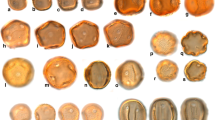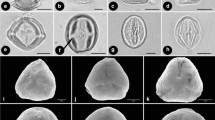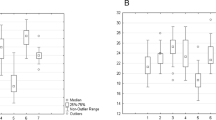Abstract
Pollen of 110 species from 18 genera in thePortulacaceae has been examined by light and scanning electron microscopy, and a representative number by transmission electron microscopy. Three basic pollen types were found: 3-colpate with thick tectum and foot layer with prominent unbranched columellae and an extremely thin endexine; pantoporate with thick tectum and foot layer with branched columellae enclosing pores and an endexine that is one to two layers thick; pantocolpate with thin tectum and foot layer with broad, short unbranched columellae and an inconspicuous endexine. All pollen types, however, have a spinulose and tubuliferous/punctate ektexine. Also, all the genera except three,Calandrinia H.B.K.,Montia L. andTalinum Adanson are stenopalynous. There is, however, no absolute correlation between pollen morphology and geographical distribution, although both the major centre of palynological diversity and the majority of all species with tricolpate grains occur in South America.
Similar content being viewed by others
Literature Cited
Alioshina L.A. (1963): Morphology of pollen grains in the genusClaytonia Gronov. and allied genera.—Bot. Zh., 48: 1191–1196.
Behnke H.-D. (1976): Ultrastructure of sieve-element plastids inCaryophyllales (Centrospermae), evidence for the delimitation and classification of the order.—Plant Syst. Evol., 126: 31–54.
Bassey C.E. (1915): The phylogenetic taxonomy of flowering plants.—Ann. Missouri Bot. Gard., 2: 109–164.
Core E. L. (1955): Plant taxonomy.—Prentice-Hall Inc. Englewood Cliffs.
Cronquist A. (1957): Outline of a new system of families and orders of dicotyledons.—Bull. Jard. Bot. Etat., 27: 13–40.
Cronquist A. (1965): The status of the general system of flowering plants.—Ann. Missouri Bot. Gard., 52: 281–303.
Ehrendorfer F. (1976): Chromosome numbers and identification of centrospermous families.—Plant Syst. Evol., 126: 27–30.
Eichler A.W. (1878): Blüthendiagramme construirt und erlautert III.—Wilhelm Engelmann, Leipzig.
Engler A. (1964): Syllabus der Pflanzenfamilien 12. Aufl. II. Band: Angiospermen.—Gebruder Borntraeger, Berlin.
Erdtman G. (1952): Pollen morphology and plant taxonomy. Angiosperms.—Almqvist & Wiksell, Stockholm.
Erdtman G. (1960): The acetolysis method.—Svensk. Bot. Tidskr., 54: 561–564.
Faegri K. (1966): Recent trends in palynology.—Bot. Rev., 22: 639–644.
Faegri K. &Iversen J. (1975): Textbook of pollen analysis, 3rd. ed. byFaegri K.— Blackwell Scientific Publications, Oxford.
Franz E. (1908): Beitrage zur Kenntnis der Portulaceen und Basellaceen.—Beibl. Bot. Jahrb., 97: 1–46.
Hallier H. (1912): L'origine et le systeme phyletique des angiospermes exposes a l'aide leur arbre genelogique.— Arch. Neerl. Sci. Exact. Nat., ser. 3B: 146–234.
Jacobsen H. (1975): Lexicon of succulent plants. 2nd. ed.—Blandford Press, Dorset.
Lawrence G. H. M. (1951): Taxonomy of vascular plants.—MacMillan, New York.
Mabry T.J. (1966): The betacyanins and betaxanthins.—In:Swain T. [ed.], Comparative phytochemistry, pp. 231–244.—Academic Press, London.
Mabry T.J. (1976): Pigment dichotomy and DNA-RNA hybridization for centrospermous families.—Plant Syst. Evol., 126: 79–94.
Mabry T.J. &Dreiding A.S. (1968): The betalains.—In: Mabry T.J., Alston R.E. & Runeckles V.C. [eds.], Recent advances in phytochemistry. Vol. 1.—Appleton, New York.
McMeill J. (1974): Synopsis of a revised classification of thePortulacaceae.—Taxon, 23: 725–728.
McNeill J. (1977): The genusTalinaria, Notes.—Southwest Natur., 22: 389–406.
Nilsson O. (1967): Studies inMontia L. andClaytonia L. and allied genera, 3: Pollen morphology.—Grana Palynol., 7: 279–363.
Nowicke J.W. (1975): Pollen morphology in the orderCentrospermae.—Grana Palynol. 15: 51–77.
Nowicke J.W. &Skavarla J.J. (1977): Pollen morphology and the relationship of thePlumbaginaceae, Polygonaceae andPrimulaceae to the orderCentrospermae.—Smithsonian Contr. Bot., 37: 1–64.
Nowicke J. W. &Skvarla J.J. (1979): Pollen morphology: The potential influence in higher order systematics. —Ann. Missouri Bot. Gard., 66:633–700.
Nyananyo B.L. (1986): Tribal and generic relationship and classification in thePortulacaceae (Centrospermae).— Ph.D. Thesis, University of Reading, England.
Nyananyo B.L. (1986): The taxonomic position ofTalinella Baillon (Portulacaceae).—Feddes Repert., 97: 771–773.
Nyananyo B.L. (1987): Seed coat morphology inCalandrinia (Portulacaceae) and its taxonomic significance.—J. Pl. Sci. Res., 3: 93–97.
Nynanyo B.L. (1988): A new nomenclatural combination inPortulacaceae (Centrospermae).—Folia Geobot. Phytotax., 23: 217.
Nyananyo B.L. &Heywood V. H. (1987): A new combination inLyallia (Portulacaceae).—Taxon, 36: 640–641.
Phillipson W.R. &Skipworth J.P. (1961):Hectorellaceae: a new family of dicotyledons.—Trans. Roy. Soc. N.Z., 1: 31.
Rao A.N. &Tian O.E. (1974): Pollen morphology of certain tropical plants.—J. Palynology, 10: 1–37.
Reiche K. (1897): Zur Systematik der chilenischen Arten der GattungCalandrinia.—Ber. Deutsch. Bot. Ges., 15: 493–503.
Rodman J.E., Oliver M.K., Nakamura R.R., McClammer J.U. &Bledsoe A.H. (1984): A taxonomic analysis and revised classification of theCentrospermae.—Syst. Bot., 9: 297–323.
Skipworth J.P. (1961): The taxonomic position ofHectorella caespitosa Hooker fil.—Trans. Roy. Soc. N.Z., 1:17–30.
Skvarla J.J. &Nowicke J.W. (1976): Ultrastructure of pollen exine in the centrospermous families.— Plant Syst. Evol., 126: 55–78.
Swanson J.R. (1966): A synopsis of relationships inMontioides (Portulacaceae).—Brittonia, 18: 229–241.
Takhtajan A.L. (1959): Die Evolution der Angiospermen.—Fischer Verlag, Jena.
Van Campo M. (1976): Patterns of pollen morphological variation within taxa.—In:Ferguson I.K. &Mueller J. [eds.], The evolutionary significance of the exine, pp. 125–137.—Academic Press, London.
Wodehouse R. P., (1935): Pollen grains.—McGraw-Hill, New York.
Author information
Authors and Affiliations
Rights and permissions
About this article
Cite this article
Nyananyo, B.L. Pollen morphology in thePortulacaceae (Centrospermae) . Folia geobot. phytotax. 27, 387–400 (1992). https://doi.org/10.1007/BF02853372
Received:
Accepted:
Published:
Issue Date:
DOI: https://doi.org/10.1007/BF02853372




